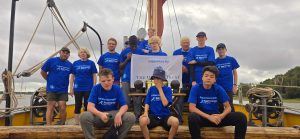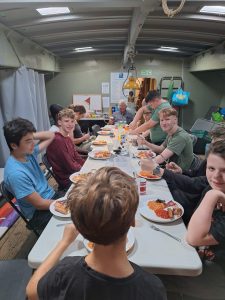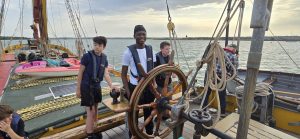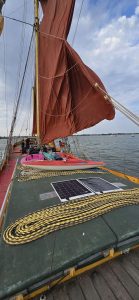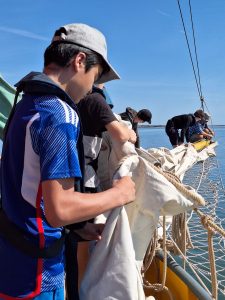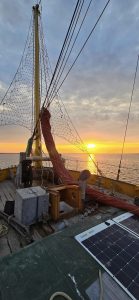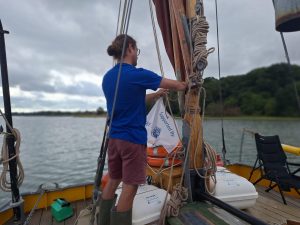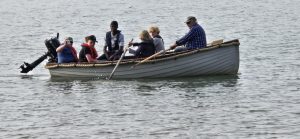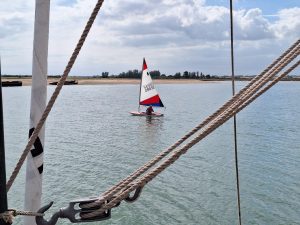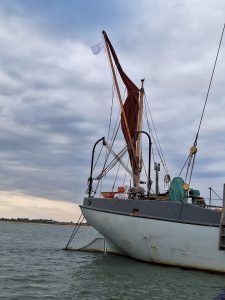The 10 male cadets and 2 Cadet Forces Adult Volunteers met excitedly at our unit ready to load the two vehicles which were to transport them to Heybridge in Essex to board the Blue Mermaid sailing barge on the River Blackwater. Blue Mermaid is the first full size Thames Sailing Barge to be built since 1930. She is a replica of a barge of the same name, which was sunk by a mine during World War II with the loss of her crew. As a traditional Thames Sailing Barge, she does not have an engine and is able to transport the equivalent of up to six articulated lorry loads in a low carbon environment when the hold is not in use by groups of young people. The 87ft. steel barge was commissioned by Sea-Change Sailing Trust, which provides residential opportunities for young people to learn and develop in a unique environment. By living and working together aboard a large traditional sailing vessel they participate in a wide range of life skills and are encouraged to take increasing responsibility for their contribution and group decisions.
On arrival at the jetty, all provisions and personnel for the 4-day voyage had to be taken from the shore in several trips by rowing the tender out to the barge anchored in the estuary. Once onboard the cadets were welcomed and given a safety and housekeeping brief by the Skipper. Of high importance was the usage of the heads (toilets) and taps which were operated by foot pedal. The sleeping accommodation was communal and incorporated in the hold by way of foldaway bunks with privacy curtains which when packed away left room for the daily activities undertaken by the cadets. Some instruction followed on tying knots, how to use the winches and the ropes, steering and three important commands “Look about, Aye ready and Ready to tack.” Two groups of five were chosen to be the watches throughout the voyage. Watch A went on deck whilst Watch B prepared the evening meal and then they set off on the rising tide.
Having left the estuary behind them, they dropped anchor to eat their evening meal, enjoying a spectacular sunset before retreating to their bunks on what had been one of the hottest days of the year. The following day the Skipper gave a talk on Reaching, Running and Fetching and the technicalities of using the wind to power the barge, using the pendant and Ulysses flag as a guide to its direction and velocity. The water was quite rough, and some cadets and adults felt seasick. Harvey’s comment was “I learnt about resilience; I didn’t like feeling ill but came through it with support from the others.” Some who were not affected took the opportunity to climb out on the bow sprit to heave on the ropes to unfurl the sail which made best use of the wind. Connor remarked
“I’ve learnt I can overcome fear of something by being encouraged by others and giving it a try.”
Michael enthused
“Using the ropes and unfurling the sail on the bow sprit was my favourite job.”
The next day’s sailing took them to the more sheltered waters of Hamford Water, an area of special scientific interest. Disembarking from the barge by watches, the cadets rowed the tender to Oakwood Creek to observe close hand the seals which were discoloured orange by the iron oxide content of mud of the creek banks. Those remaining on board had fun crabbing using some left-over ham as the bait to catch just a few little crabs, but a first for all those involved. The tender was also used to tow two toppers, manned by cadets, to a secluded beach area where some cadets were able to enjoy the simple task of digging a big hole while others spent time beach combing, surprising the skipper by discovering some gem like pebbles which were quite beautiful. Several of the cadets enjoyed sailing solo while others did some wild swimming. Two cadets had impressed the skipper so sailed the toppers back independently having been deemed competent to do so. Luke said,
“The sense of freedom sailing solo in the Topper was wonderful.”
The busy waters of the North Sea were then navigated through different sea lanes, frequently changing radio channels, into the River Orwell, all the while battling a wind force 7, the highest the barge could handle and certainly challenging for those with a tendency to sea sickness, but giving them the experience of the speed of the barge as it cut through the water, listing in the force of the wind. The cadets were fully involved in handling the barge with one cadet reporting his enjoyment of this experience and asking to take the helm on more occasions. Dropping anchor at Stone Point the cadets went shore again, taking turns to row, to explore the wet land area which is noted for the numerous carcasses of boats and known as the graveyard of boats and ships.
Each watch took their turn at preparing the meals in the tiny galley with limited facilities, feeding the Captain and his Mate too. The only electricity, provided by two small solar panels, was for the safety lighting and essential navigation equipment required by law. There was no fridge, so all the food had to be of a low perishable nature and packaging had to be minimal as all rubbish had to be stored until the end of the journey. Who knew how popular custard from a carton would be? Living in close proximity with thirteen other people was a very new experience, bringing some tensions on occasions which had to be worked through by the group to enable the voyage to continue convivially. Working as a team was essential for the success of the voyage so compromise and tolerance was a life lesson all the cadets learnt. For some it was the first time away from home, but they were supported through their homesickness by the group, and the 30 minutes mobile phone time allowed whilst their batteries stayed powered up. Evenings were filled with thought-provoking discussions known as “pudding talks” such as “where you like to visit in the world and why?”, with some surprising responses, and “who would you like to meet and have dinner with, dead or alive” A few cadets shared their longing to see again a lost relative, and this led to the sharing of empathy by those listening. Throughout the voyage the cadets were responsible for keeping the barge shipshape and were commended for their use of the contents of the brasso tin on the compass and parts of the wheel and keeping the Skipper topped up with copious cups of tea, which they all seemed to drink a lot of.
The voyage ended with the presentation of awards and reports. On their voyage in 2023 another group of Gravesend Sea Cadets had piloted the Traditional Seafarer Introductory Certificate which is now being awarded nationally so all this year’s ship’s compliment were awarded this.
Returning to shore and the waiting vehicles all personal belongings were stowed in the waiting vehicles. The final sweep of the quarters aboard blue mermaid had been done but only on unloading back at the unit was it discovered that the unit’s box of foul weather gear, unused during the voyage had been left on board. Fortunately, Blue Mermaid will be sailing up the River Thames and past our unit on the 22nd of September 2024 so we will be able to retrieve it then and return the “captain’s cushion” which they did manage to bring back!!


